![How to Write a Follow-Up Email After No Response [4 Templates That Work!]](https://outreachbin.com/wp-content/uploads/2021/03/unsplash-image_f483edec10bcd2c77806bcb8878495e2_2000.jpg)
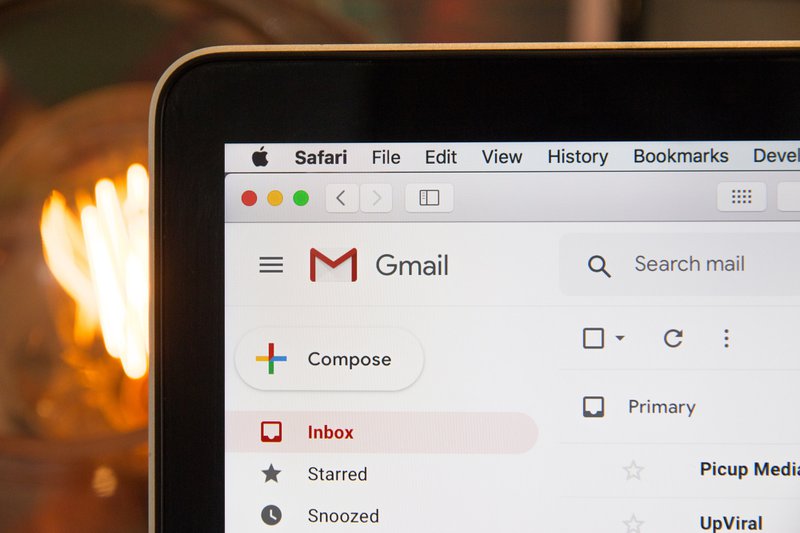
Your business will occasionally require more than a few "tries" before you hear back from your prospects.
However, the issue is nobody really wants to send follow-up emails. They write one email but never communicate with that person again. In reality, seventy percent of sales emails don't go beyond the first attempt.
Struggling with following-up with your prospects? This article will address the most frequently asked questions that sales and marketers face and provide necessary guidance on how to write a follow-up email that thrives.
But first, we need to know why it’s important, how long you should wait before sending out your follow-up email, how many emails to send, and other details about follow-up emails.
We receive tons of emails every day. It’s not practically possible for someone to check every single email he/she receives. Besides, many emails land in our spam section. So, it’s very likely that your cold email may get lost.
Usually, people prioritize their emails coming from colleagues, friends, and families. Your cold emails will normally be their second priority. Consequently, these emails get lost or ignored.
In this situation, follow-up emails are your best bet. These work as gentle reminders that your prospects might have missed your email or failed to get in contact with you. But just asking your prospects whether they have seen your previous cold email is not enough. Follow-up emails tend to miss an essential part, i.e., additional value.
Do you have a product or service that is too difficult to explain? Include additional details in the next email, along with the incentives for your prospect.
Follow-ups, therefore, provide a rare opportunity yet again to grab the interest of prospects and provide them with more detail on your proposition.
Before setting the numbers, you need to ask yourself one thing. “Do I really have any reason to follow-up?” If your answer is yes, then you should know how many follow-up emails you should send. You don’t want to make your prospects feel like you’re desperate.
You might ask, "What if the cause is that I haven't received a reply yet?"
Well, it makes sense to inquire respectfully, for your first follow-up, if your prospect had the chance to take a look at your proposition or discuss it with their peers. But regardless, I suggest that you add value to each new email.
In each of your follow-up emails, you can't complain, "Why am I still waiting for your reply?"
So, if you think about how many follow-ups you should send to your prospects, think about whether you have a purpose.
There’s a lot of research on the appropriate number of follow-up emails for cold e-mail campaigns. But at OutReachBin, rather than concentrating on follow-up emails, we focus on writing emails that your prospects can’t resist. Therefore, we suggest that you have at least three follow-up emails to your cold email campaigns.
You don’t want to sound desperate and annoy your prospects. However, if you keep sending someone emails about your offer who haven’t heard about you before, it will just ruin your brand image.
If you still feel that three follow-ups would not be enough or that you can offer more value or pique their interest—do not hesitate to use other channels. Twitter or LinkedIn could effectively help you deliver your message personally.
To be honest, the number of follow-ups will depend on your outreach campaign and audience.
You might get almost half of the responses just by sending one follow-up email. If you send more than one, you might annoy your prospects and lose your potential prospects. Similarly, if you don’t send any, you’ll lose all your prospects.
On the other hand, if your aim is to generate sales, you’ll need more than one follow-up probably more like 7! Depending on the target, you can provide incremental benefits with follow-ups. You can try to find the pain point of your prospect, provide additional useful information, etc.
If you send an email to a totally cold audience, you would need to send more follow-up emails to warm them up. It also takes them some time to think about your offer before they get back to you.
Nevertheless, if the prospect is acquainted with you (for example, they've accessed your resources earlier), fewer follow-ups will be required.
To sum it up, our suggestion would be to identify what works the best for you. Try to find the balance between being too steep and being inactive. Evaluate various lengths of follow-up sequences. Stick to the one that you think suits your brand.
Approximately 90% of emails are read on the very same day they have been sent. The same goes for the replies and responses. The odds are that your prospects will come back to you the same day that your message has been sent out are much higher.
So don't take too long to send your follow-up query. Commonly, we recommend taking 2–5 days as it is the best time to remind prospects of your email.
Often it might take a little longer. For instance, you’ve sent your cold emails on Wednesday or Thursday. If you don’t get replies back, send follow-up emails on Monday or any other workdays. As it’s very much likely that your prospects won’t bother opening your cold emails on weekends, it is wise not to send emails on weekends.
In the case of a series of follow-up emails, more days of gaps are required for each new email you send. This will help you to keep in the game and not appear distracting at the same time.
Although there is no fixed rule on how long you should wait before sending follow-up emails, you can and should experiment by sending follow-up emails changing the days' gap.
OutReachBin can help you out with your cold emails as well as follow-up emails. It not only helps you send personalized emails but also allows you to choose the gap between the emails. But how to automate your emails? Let’s find out.
It’s difficult for anyone to manage hundreds and thousands of prospects manually. That’s why a sales engagement as well as an email marketing tool like OutReachBin can help you create effective automated cold email campaigns.
With OutReachBin, you not only can personalize a bulk number of cold emails but also schedule follow-up emails according to your preferences. These follow-up emails are those that are paused or triggered on the basis of whether a recipient opens an email, clicks on it, or responds. By default, you’ll see three steps when you create a new campaign, but you can change that according to your necessity.
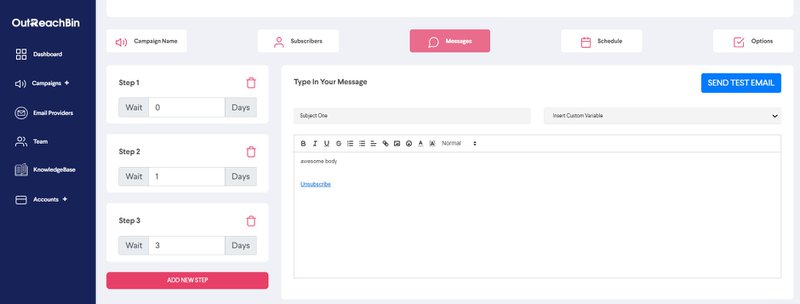
You can also see the rundown from your OutReachBin dashboard. Furthermore, you can set the timezone and days you want to send emails according to your audience. We recommend you not to send on weekends. In addition to these, you can also set max reach per sequence step each day. The schedule tab will look like this:
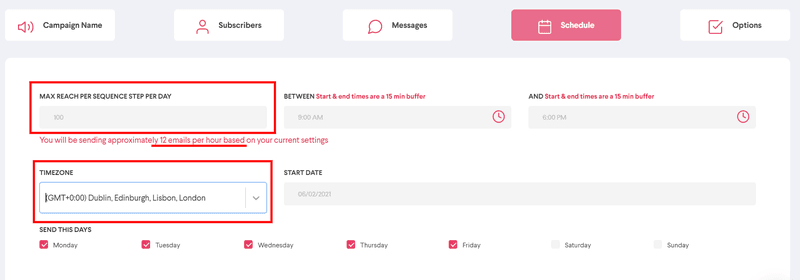
Enhance your overall outreach approach by A/B testing subject lines, body text, and whole message sequences. Use custom variables while writing the email body. OutReachBin offers you custom variables that are generated automatically while you upload your CSV file. It makes your tasks easier. Here’s how it looks:
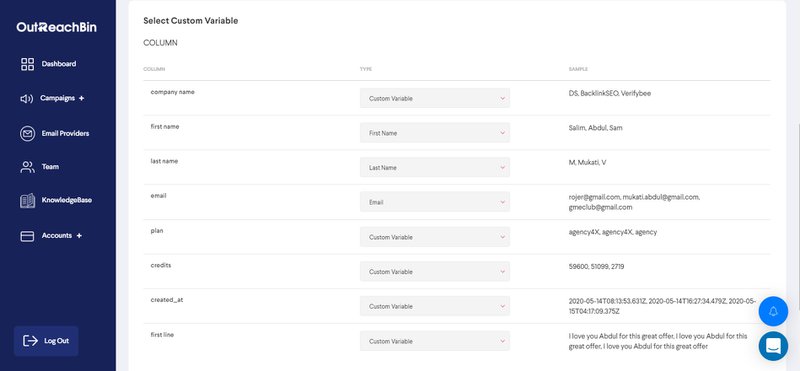
Some might think automated campaigns affect your outreach program. But the bottom line is that while follow-up emails are necessary, there’s no reason why you can’t automate it.
Before writing and sending follow-up emails, you need to fix your goals and decide what you want to achieve by giving out these emails.
You would want, for starters, to:
We can't assist you a lot here because every case is different. Exactly what you want and need to get out of a follow-up email is likely to change with every campaign you're working on and possibly even between every follow-up you're sending.
Never send emails – follow up or otherwise – if you don't know precisely what you want to get out of them.
Try to trigger your prospect's mind by introducing your email with reference to your earlier message or conversation. Even if your receiver draws a blank, they are more likely to respond favorably to the follow-up if they have been notified of the fact that they've communicated with you before.
Your opening line might include any of the following:
You must never send a follow-up without upping the ante and showing your value.
Avoid sending lazy follow-ups. These follow-up emails don't contribute anything but one more email to your mailbox. Add value with each follow-up. Make it worth your while to open, tap, and reply.
Opportunities for organic, natural interactions and follow-ups emerge from offering them something useful as a gift, whether it be a tangible object or a webinar, case study, template, or other accessible resources.
You will easily get 3-5 follow-ups on these value-added deals. Make it of high quality and relevant to them. You're trying to be something of an asset to them.
If you don't have any kind of added benefit, there is very little motivation to approach them and even less incentive for them to answer or care.
Explain the reason for your follow-up email in a straightforward and clear manner. Tell the receiver precisely what you want. If your intention or purpose hasn't modified after your last message, remind them. If you’re looking for ways to remind them, here are 3 lines that you can use.
Make the emails more about them. They don’t care about what you believe or think. So make them feel valuable.
Make it simple for the receiver to reply. For instance, if you're trying to organize a meeting, recommend a particular date and time (and location, if you're organizing a physical meeting).
A lot of advertisers and sales staff make the mistake of keeping things unclear and ambiguous. Make your call-to-action crystal clear and tempting. What would you like them to do? Inform them about it.
Wrap your follow-ups in a way that seems sympathetic to the interactions you have had so far with your prospect. Try out the following lines:
If the above recommendations are not enough for you to begin with, here are a few examples of the follow-up email templates that we deliver to our prospects at OutReachBin.
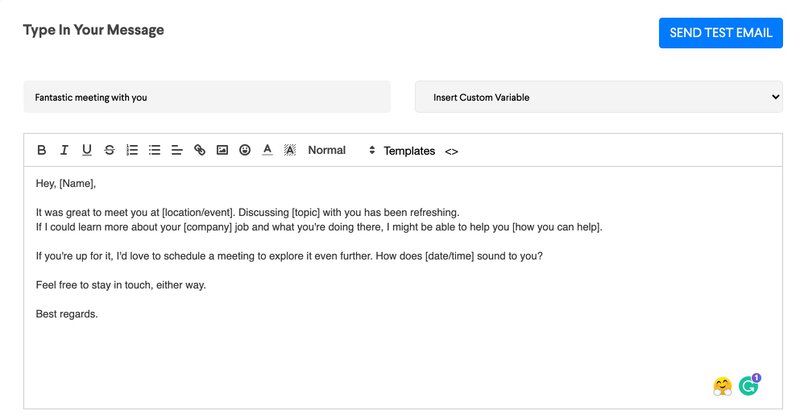
Subject Line: Fantastic meeting with you
Hey, [Name],
It was great to meet you at [location/event]. Discussing [topic] with you has been refreshing. If I could learn more about your [company] job and what you're doing there, I might be able to help you [how you can help].
If you're up for it, I'd love to schedule a meeting to explore it even further. How does [date/time] sound to you?
Feel free to stay in touch, either way.
Best regards.
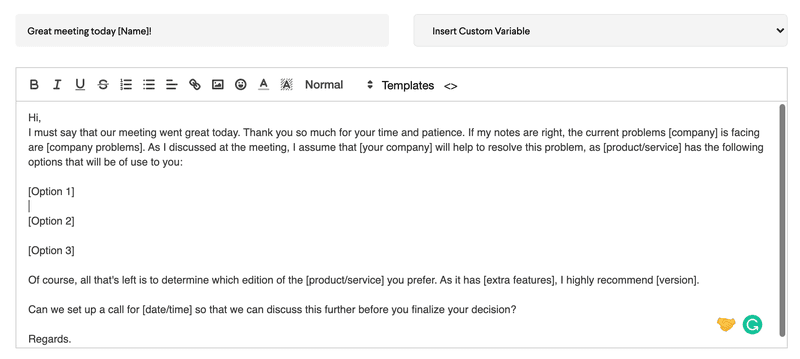
Subject Line: Great meeting today [Name]!
Hi,
I must say that our meeting went great today. Thank you so much for your time and patience. If my notes are right, the current problems [company] is facing are [company problems]. As I discussed at the meeting, I assume that [your company] will help to resolve this problem, as [product/service] has the following options that will be of use to you:
[Option 1]
[Option 2]
[Option 3]
Of course, all that's left is to determine which edition of the [product/service] you prefer. As it has [extra features], I highly recommend [version].
Can we set up a call for [date/time] so that we can discuss this further before you finalize your decision?
Regards.

Subject Line: Thank you for the meeting
Hi, [Name],
Thank you for the meeting today. It also made me realize how [your company] would benefit [company]. I'm looking ahead to our next meeting, but meanwhile, I wanted to ask, [information you need]?
Thank you in advance.
Best regards.
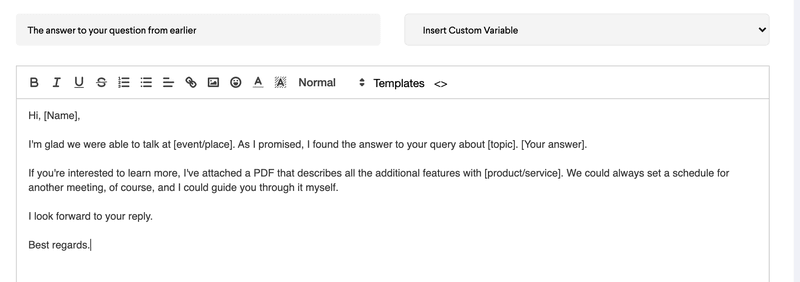
Subject Line: The answer to your question from earlier
Hi, [Name],
I'm glad we were able to talk at [event/place]. As I promised, I found the answer to your query about [topic]. [Your answer].
If you're interested to learn more, I've attached a PDF that describes all the additional features with [product/service]. We could always set a schedule for another meeting, of course, and I could guide you through it myself.
I look forward to your reply.
Best regards.
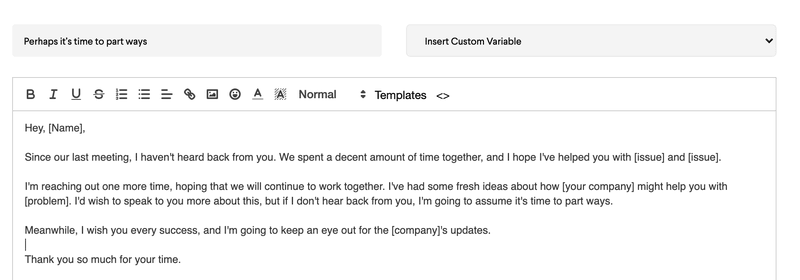
Subject Line: Perhaps it’s time to part ways
Hey, [Name],
Since our last meeting, I haven't heard back from you. We spent a decent amount of time together, and I hope I've helped you with [issue] and [issue].
I'm reaching out one more time, hoping that we will continue to work together. I've had some fresh ideas about how [your company] might help you with [problem]. I'd wish to speak to you more about this, but if I don't hear back from you, I'm going to assume it's time to part ways.
Meanwhile, I wish you every success, and I'm going to keep an eye out for the [company]'s updates.
Thank you so much for your time.
All of these are only one potential variant out of a million. Essentially, everything depends on the precise needs of your company and the situations of your follow-up emails.
It's pretty hard to get the attention of someone who did not respond to you before.
This is why, when writing your follow-ups, make your primary emphasis on value creation and offering enticing deals instead of swamping your prospects with a lot of follow-ups.
Write a witty intro to make your targets read your email, keep them concise so that it doesn't lose their focus. Do your homework to customize high-end follow-ups.
By implementing these general tenets, we are sure that you will be able to start a conversation quickly with your prospects.





